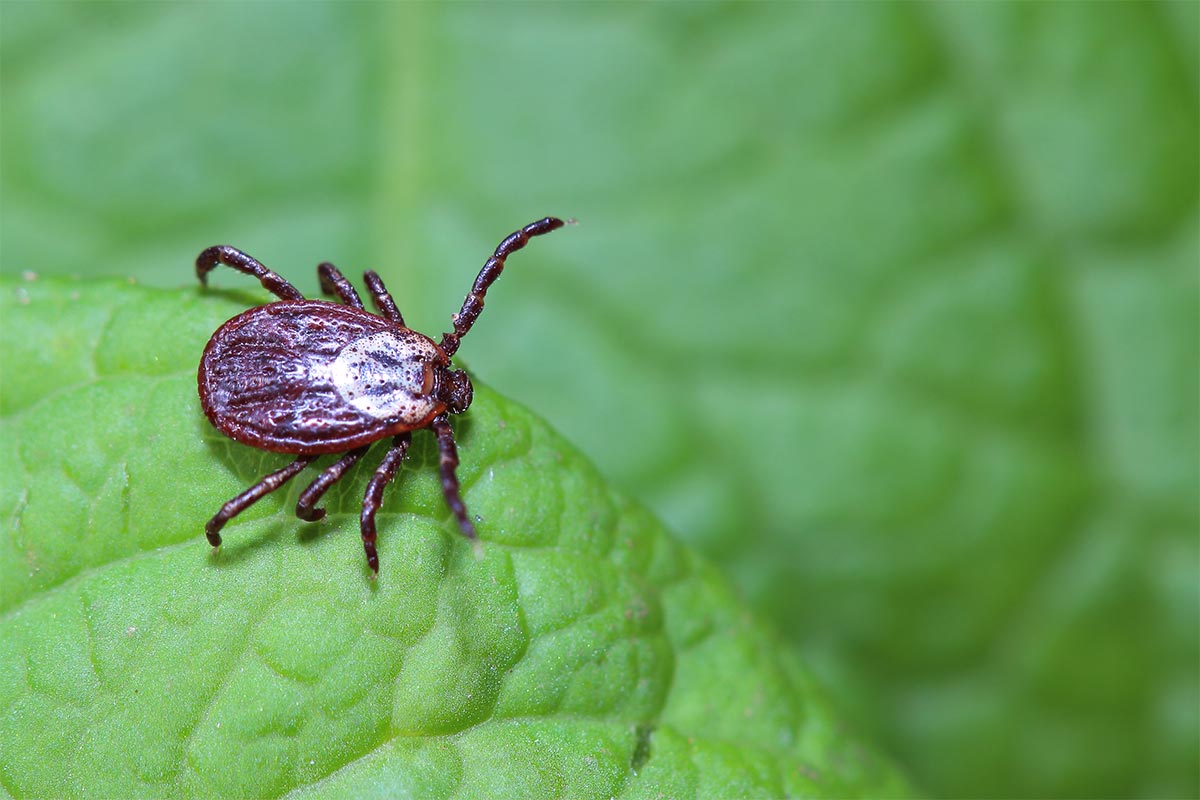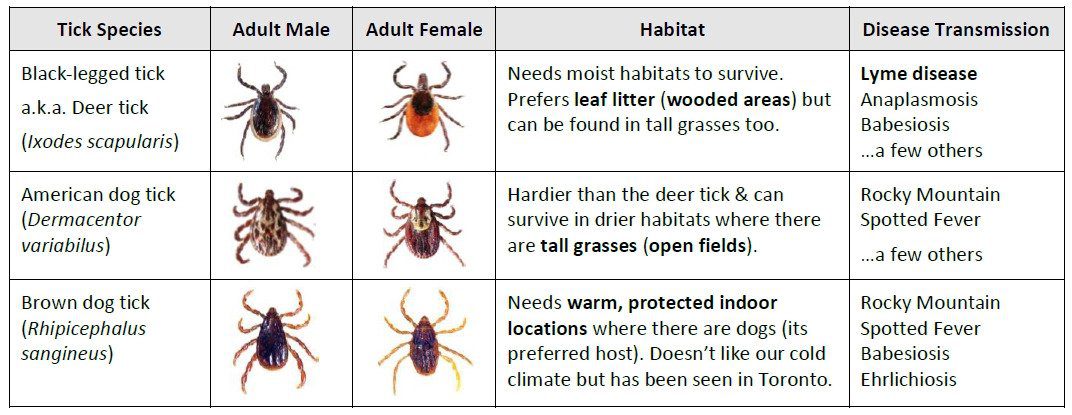Over the years, ticks have been hitching a ride on migratory birds and making their way to Ontario and bringing certain diseases with them. Understanding how ticks behave and what you can do to avoid acquiring tickborne diseases will help ensure that you and your pet continue to enjoy your time outdoors safely.
What Exactly Is a Tick and Why Are Ticks a Concern?
Ticks are external parasites that belong to the same family as spiders. Adult ticks have 8 legs, 2 body parts, a flat body (when their bellies aren’t full of a blood meal), and a hard outer skeleton (hard to squish and best not to try in case you release diseases a tick may carry). Adults lay eggs (thousands of them at a time!), eggs hatch into larvae, larvae molt into nymphs, and nymphs mature into adults that go on to lay more eggs. Adult ticks and nymphs can carry diseases that can be transmitted to you and your pet when they attach and feed. While not all ticks carry disease, some do, and their numbers are growing.
Understanding Tick Behavior
Unlike fleas and mosquitoes, ticks can’t jump or fly onto their hosts. Instead, they “quest” – clinging to vegetation (e.g., a leaf or a tall piece of grass) with their back legs and reaching out with their front ones to grab on and climb aboard a passing host (a bird, rodent, deer, you, your pet, and so on). Ticks can sense a potential host through body heat and vibrations.

Once on board, ticks settle where they land or crawl to a better feeding spot (near an ear where skin is thin and easy to penetrate, for example). They’re pretty hungry at this point and literally ‘face plant’ to feed, embedding their heads into skin and sucking up blood through a feeding tube for several days, then falling off their host once they’ve had their fill. You’d think we’d notice an attached tick, but ticks are really small (hard to see until they’re engorged with a blood meal), and some species release a kind of local anesthetic when they feed so their hosts don’t notice they’re there. Note: It’s only while adult ticks or nymphs are feeding that they can pick up a disease carried by one host and pass it on to another.
Which Ticks Are a Concern?
Species of ticks found in Canada that will feed on pets or people are listed below. The ones of greatest concern are the Deer tick and American dog tick. (Brown dog ticks are uncommon, and Lone Star tick populations have remained low. They’re a greater concern if you’re spending time in parts of the U.S.) The incidence of most tickborne diseases is still pretty low in Canada. But black-legged ticks that transmit Lyme disease in particular are growing in numbers, including in our area. You can learn more, participate in tick tracking, and/or submit photos of a tick for identification at etick.ca, and capcvet.ca.

When Is Tick Prevention Recommended?
Adult ticks are most active in the spring and fall. Nymphs are active in the summer. Nymphs pose the greater risk to people because they’re around at a time when people are wearing shorts and tee-shirts and have more skin exposed, and nymphs are so tiny (1-2 mm in diameter!) they’re hard to spot. That said, there’s no such thing as a season for ticks. If the temperature is greater than 4°C (let’s say above freezing to be safe), ticks will be out questing for a meal. For years now, temperatures have supported tick activity off and on throughout our winter months. In our part of Ontario, people and their pets need year-round protection from ticks.
How Can I Protect Myself and My Pet?
We recommend appropriate preventive medication for your dog or outdoor cat, appropriate clothing and bug spray for you, staying on trails and keeping your dog on a leash, and doing tick checks after you or your pet have been outdoors. It takes as little as 24 to 48 hours for the black-legged tick to transmit the bacterium that causes Lyme disease, so the sooner you remove any ticks, the better. If you find a tick on your dog, we can run a quick blood test to check for exposure to disease. The same test isn’t available for cats but other testing can be performed.
For year-round tick prevention as well as coverage for other parasites (fleas, heartworm transmitted by mosquitoes, mites, roundworms, hookworms, and whipworms), we recommend the monthly oral chewable NexGard SPECTRA® for dogs. For outdoor cats, we recommend monthly topical NexGard COMBO® (applied to the skin). Nexgard COMBO® covers the same spectrum of parasites as NexGard SPECTRA® as well as tapeworms. We’ve adopted these as our ‘go to’ preventives for their broad-spectrum coverage (the parasites of greatest concern in our area) and for their excellent safety and efficacy.

What’s the Best Way to Remove a Tick?
Bring your pet in and we’ll show you! The goal is to remove the tick with its mouth parts intact. Anything left behind will cause a reaction under the skin. Grasp the tick close to the skin with tweezers and gently but firmly lift upward. Or use a 2-pronged tool such as the one pictured to the right (we can give you one):
- Pick the large or small one depending on the size of the tick.
- Engage the tick between the prongs of the tool approaching it from the side.
- Gently lift and turn (clockwise or counterclockwise) until the tick releases its hold.
- Disinfect the bite site and wash your hands.
DO NOT put oils, Vaseline, or other concoctions on the tick; it may cause the tick to regurgitate into its host – exactly what we don’t want!
How Worried Do I Need to Be About Lyme Disease?
About 1 in 5 black-legged ticks in Ontario carry the bacterium (Borrelia burgdorferi ) that causes Lyme disease (less in some areas, more in others). Most dogs that are exposed to Borrelia don’t get sick. In fact, only about 5% of dogs develop symptoms of Lyme disease: a lameness that shifts from one leg to another, fever, lethargy, and a loss of appetite. And they can be treated successfully with antibiotics. But left untreated, about 1% of those that get sick develop Lyme nephritis (an immune-mediated disease of the kidneys that’s often fatal). No one wants their pet to be in that 5% or 1%. Better to be safe and prevent disease transmission altogether, not to mention preventing a female tick from laying thousands of eggs.
People can also develop serious complications of Lyme disease if it’s not treated. If you develop flu-like symptoms (aches, pains, headaches) or a bulls-eye-like or other rash where you may have been bitten by a tick, please see your family physician. While Lyme disease is serious, it’s also entirely preventable if you take appropriate precautions.
